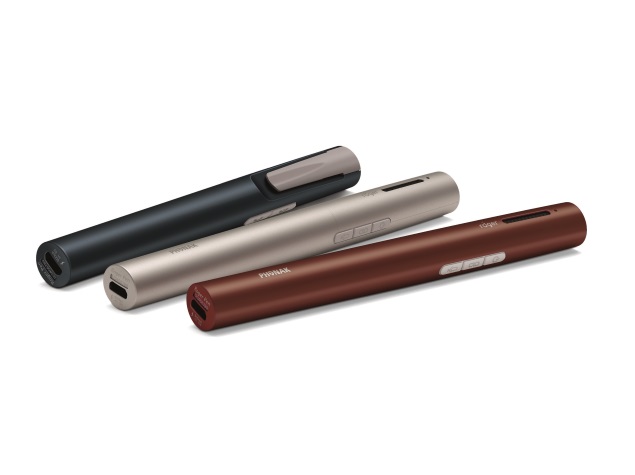- Home
- Others
- Others News
- Sonova's Microphone Disguised as a Pen Offers 'Super Normal Hearing'
Sonova's Microphone Disguised as a Pen Offers 'Super Normal Hearing'

As the population ages, the hearing aid industry has become fiercely competitive as manufacturers rush to launch devices packed with newer technologies that will increase the appeal of wearing one.
Sonova is banking on new products to maintain its lead as the world's biggest hearing aid maker. Around 70 percent of its hearing aid revenue comes from products that have been on the market for less than two years.
The company's microphone, called "Roger" after the term used in radio communications to say a message has been received, wirelessly transmits a speaker's voice over a 2.4 gigahertz (GHz) frequency to a tiny receiver that clips onto the aid.
The pen - which can be placed flat on table, used like a microphone or hung around a speaker's neck - makes speech more intelligible over distance and when there is background noise, such as in a busy restaurant, in a meeting, or in the car.
"It's very beneficial if the speech target is a little bit further away not just sitting in arm's reach length, such as across a table or across a schoolroom," said Stefan Launer, head of science and technology at Sonova.
The World Health Organisation estimates 5 percent of the world's population - 360 million people - has a disabling loss of hearing.
A study published in the American Journal of Audiology found people with moderate-to-severe hearing loss who used the Roger Pen could understand speech better than those with normal hearing at noise levels of 65 decibels (dB) and above.
Although Sonova does not give sales figures for its Roger Pen, its launch helped lift revenue in its wireless communication systems business almost 19 percent in the second half of the 2013/14 year.
The Swiss company has a market share of around 24 percent, followed by William Demant with 23 percent, Siemens with 17 percent and Denmark's GN Resound, the hearing aid unit of GN Store Nord, in fourth place with 16 percent.
While competitors offer wireless microphones, Kevin Taylor, head of technology at British charity Action on Hearing Loss, said Roger's discrete pen shape and its ability to switch between amplifying sounds from all directions or just one made it stand out from other devices.
Rivals also want to increase the appeal of hearing aids. GN Resound has launched the LiNX hearing aid that lets users listen to calls and music from their iPhone, which it hopes will banish the stigma of wearing a device by linking hearing aids to a fashionable brand.
But despite offering "super normal hearing", Sonova's Launer acknowledged technology may have its limits.
"The auditory system has millions of years of evolution and it has features that are very, very difficult to copy," he said. "Given all the computational power the brain has, it's just something very hard to beat in a technical device."
© Thomson Reuters 2014
Catch the latest from the Consumer Electronics Show on Gadgets 360, at our CES 2026 hub.
Related Stories
- Samsung Galaxy Unpacked 2025
- ChatGPT
- Redmi Note 14 Pro+
- iPhone 16
- Apple Vision Pro
- Oneplus 12
- OnePlus Nord CE 3 Lite 5G
- iPhone 13
- Xiaomi 14 Pro
- Oppo Find N3
- Tecno Spark Go (2023)
- Realme V30
- Best Phones Under 25000
- Samsung Galaxy S24 Series
- Cryptocurrency
- iQoo 12
- Samsung Galaxy S24 Ultra
- Giottus
- Samsung Galaxy Z Flip 5
- Apple 'Scary Fast'
- Housefull 5
- GoPro Hero 12 Black Review
- Invincible Season 2
- JioGlass
- HD Ready TV
- Laptop Under 50000
- Smartwatch Under 10000
- Latest Mobile Phones
- Compare Phones
- Tecno Spark Go 3
- iQOO Z11 Turbo
- OPPO A6c
- Samsung Galaxy A07 5G
- Vivo Y500i
- OnePlus Turbo 6V
- OnePlus Turbo 6
- Itel Zeno 20 Max
- Lenovo Yoga Slim 7x (2025)
- Lenovo Yoga Slim 7a
- Lenovo Idea Tab Plus
- Realme Pad 3
- Garmin Quatix 8 Pro
- NoiseFit Pro 6R
- Haier H5E Series
- Acerpure Nitro Z Series 100-inch QLED TV
- Asus ROG Ally
- Nintendo Switch Lite
- Haier 1.6 Ton 5 Star Inverter Split AC (HSU19G-MZAID5BN-INV)
- Haier 1.6 Ton 5 Star Inverter Split AC (HSU19G-MZAIM5BN-INV)
















